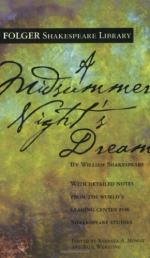|
This section contains 8,714 words (approx. 30 pages at 300 words per page) |

|
SOURCE: “Myth and Ritual in Shakespeare: A Midsummer Night's Dream,” in Textual Strategies: Perspectives in Post-Structuralist Criticism, edited by Josué V. Harari, Cornell University Press, 1979, pp. 189-212.
In the following essay, Girard explores the relationship between rhetoric, reversals, and conflicts of imitative desire in A Midsummer Night's Dream and Shakespeare's representation of “a serious genetic theory of myth” in the play.
I have considered, our whole life is like a Play: wherein every man, forgetfull of himselfe, is in travaile with expression of another. Nay, wee so insist in imitating others, as wee cannot (when it is necessary) returne to ourselves: like Children, that imitate the vices of Stammerers so long, till at last they become such; and make the habit to another nature, as it is never forgotten.
—Ben Jonson, Timber of Discoveries
The opening scene of A Midsummer Night's Dream leads the audience to expect an...
|
This section contains 8,714 words (approx. 30 pages at 300 words per page) |

|


